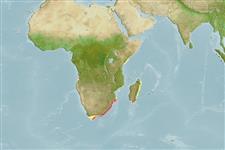Klassifizierung / Names
Namen | Synonyme | Catalog of Fishes(Gattung, Arten) | ITIS | CoL | WoRMS | Cloffa
>
Perciformes/Serranoidei (Groupers) >
Anthiadidae (Fairy basslets or Streamer basses)
Etymology: Plectranthias: Greek, plektron = anyhting to strike with, spur + Greek, anthias = a fish, Sparus aurata (Ref. 45335); elaine: Named for Elaine Heemstra.
Eponymy: Elaine Margaret Heemstra née Lawrence formerly Grant is Scientific Illustrator Emeritus at the South Africa Institute for Aquatic Biodiversity. [...] (Ref. 128868), visit book page.
More on authors: Heemstra & Randall.
Environment: milieu / climate zone / depth range / distribution range
Ökologie
seewasser; tiefenbereich 68 - 114 m (Ref. 81822). Temperate
Western Indian Ocean: South Africa.
Size / Gewicht / Alter
Maturity: Lm ? range ? - ? cm
Max length : 5.6 cm SL Männchen/unbestimmt; (Ref. 81822)
Kurzbeschreibung
Bestimmungsschlüssel | Morphologie | Morphometrie
Rückenflossenstacheln (insgesamt) : 10; Rückenflossenweichstrahlen (insgesamt) : 15; Afterflossenstacheln: 3; Afterflossenweichstrahlen: 7. This species has the following characters: color when fresh, dull red on head and body, shading to pale yellow ventrally, bases of median and pectoral fins irregular pale yellow or with white blotches; spinous dorsal fin is pale bluish white, as if daubed with thick paint; upper lip pale, with several red or white vertical bars; iris reddish orange, with short thin radiating blue-grey streaks. D X, 15, the fin margin moderately notched before soft-rayed part, with 3rd spine longest (24-30% SL), 1.8 in head length, short cirrus behind tips of spines 3, 4 and 5; A III,7, with 2nd spine longest, 2nd and 3rd anal-fin rays elongated; pectoral fins 14 rays, all branched except upper and lowermost 2 or 3 rays, fin reaching vertical at 3rd (4th) anal-fin ray; caudal fin slightly emarginate, principal rays 17, branched rays 15, 3 uppermost principal rays slightly produced; pelvic fins not reaching anus. Oval body with depth 2.1-2.5), head length 2.2-2.4, peduncle depth 7.2 (& 7.6) in SL; orbit diameter greater than snout length, 3.8 (3.4), snout length 4.8 (4.4-5.0), bony interorbital width 7.4 (9.8) in head length. Completer lateral-line with 31 (28, 30) tubed scales, 2 rows of large scales between middle dorsal fin spines and lateral-line and 3 scales from dorsal SL; orbit diameter 3.6-3.9, snout length, 4.1-4.8, bony interorbital width 8.0-8.5, all in head length. Lateral line incomplete, ending below middle of soft dorsal fin, with 16-20 tubed scales; 1 row of large scales between 5th dorsal-fin spine and lateral-line; circum-peduncular scales 12; scales on top of head extend to rear nostrils; operculum scaly, with 5-7 oblique series of large scales on cheek and a series along interopercle; snout suborbitals and lower jaw naked. Maxilla reaches past vertical at rear edge of eye; a row of 7-11 small ctenoid scales along (below) dorsal ledge of maxilla. Preopercle edge with 14-20 coarse serrae posteriorly; no antrorse spine on lower edge; subopercle and interopercle with 7-9 coarse serrae. Gill-rakers 4-5 / 9-11. Two supraneural bones, /0+0/2/1+1/1/1/ (Ref. 81822).
Life cycle and mating behavior
Geschlechtsreife | Fortpflanzung | Ablaichen | Eier | Fecundity | Larven
Heemstra, P.C. and J.E. Randall, 2009. A review of the anthiine fish genus Plectranthias (Perciformes: Serranidae) of the Western Indian Ocean, with description of a new species, and a key to the species. Smithiana Bull. 10:3-17. (Ref. 81822)
IUCN Rote Liste Status (Ref. 130435: Version 2024-1)
Bedrohung für Menschen
Harmless
Nutzung durch Menschen
Tools
Zusatzinformationen
Download XML
Internet Quellen
Estimates based on models
Preferred temperature (Ref.
123201): 13 - 23.1, mean 20.7 °C (based on 9 cells).
Phylogenetic diversity index (Ref.
82804): PD
50 = 0.5000 [Uniqueness, from 0.5 = low to 2.0 = high].
Bayesian length-weight: a=0.01000 (0.00244 - 0.04107), b=3.04 (2.81 - 3.27), in cm total length, based on all LWR estimates for this body shape (Ref.
93245).
Trophic level (Ref.
69278): 3.6 ±0.6 se; based on size and trophs of closest relatives
Widerstandsfähigkeit (Ref.
120179): hoch, Verdopplung der Population dauert weniger als 15 Monate. (Preliminary K or Fecundity.).
Fishing Vulnerability (Ref.
59153): Low vulnerability (10 of 100).
